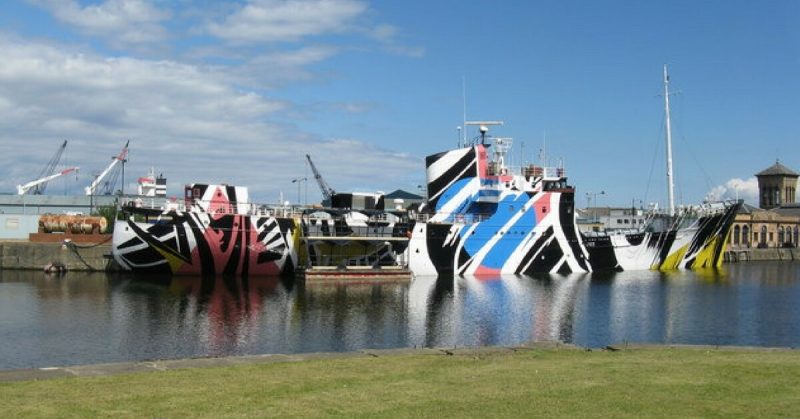Dazzle camouflage was the brainchild of British artist Norman Wilkinson. It was put forward as a solution to the problem that ships could not be camouflaged in the same way as tanks or other military vehicles.
Wilkinson was possibly inspired by the cubist movement and artists like Picasso, who deliberately distorted angles and perspective for artistic effect. If the same technique was applied to ships, it would not make them harder to see, but it could make it more difficult for an enemy to judge distance, direction, and speed of the vessel accurately which would give them a military advantage. It would also make it hard to tell which type of ship was approaching.
Earlier attempts to disguise ships included hiding gun ports behind a canvas which was painted to look like the body of the ship, or adding painted false gunports to confuse the enemy. Wilkinson’s theory was that although the “masses of strongly contrasting color” used in the design could, in fact, make the ship more visible, this apparent disadvantage was outweighed by the fact that it would be much harder to hit.
The patterns used included bold geometric shapes painted in strongly contrasting colors. Bold lines interrupted and intersected each other at unusual angles to create a disorienting distorted effect. This is quite different from most of the camouflage found in the natural world which uses disruptive coloration to help the animal merge with its environment.
The leopard’s spot pattern or the tiger’s irregular stripes are typical of this effect. This approach is also the basis of traditional military camouflage as it allows the object or person to merge with the background. But for a ship at sea, there is no background, so a different approach was required.
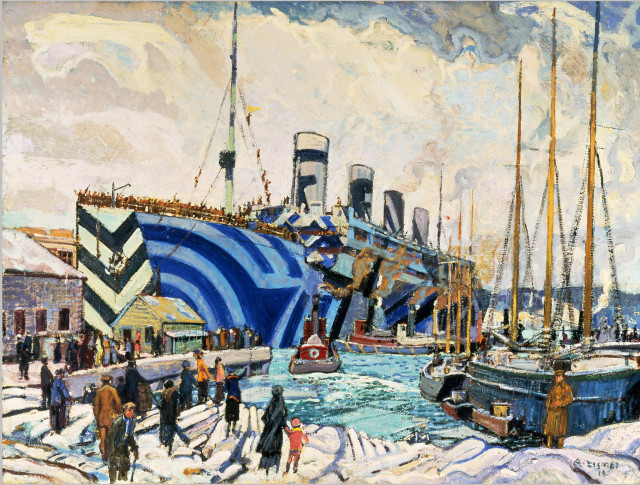
Black and white stripes were the basis of many of the patterns used in dazzle camouflage although each ship had its own unique pattern. The stripes were painted at confusing angles instead of following the lines and form of the vessel, making it hard for the enemy to judge speed, direction, distance or type of vessel. The uniqueness of each design ensured that the patterning gave no clue as to the type of vessel and to maximize this effect designers ensured that there was no correlation between the class of vessel and the style of camouflage used.
USS Leviathan
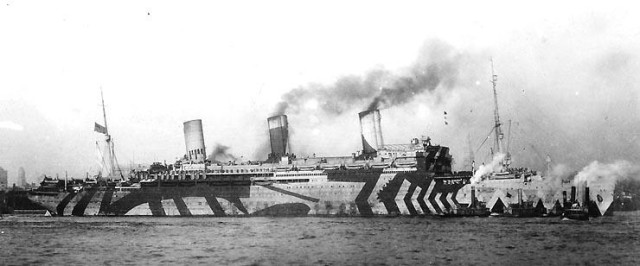
The USS Leviathan was originally built as a passenger cruiser for the Hamburg America Line and named the Vaterland. The ship was in dock in New Jersey being refitted to carry troops when the United States entered the First World War in 1917.
The Americans seized the vessel and put it into action for the Allies in September 1915. The picture above shows the Leviathan in New York Harbour in July 1918, painted in bold geometric dazzle camouflage.
RMS Olympic
RMS Olympic, which was the Titanic’s sister ship, also began as a passenger cruiser, this time for the White Star Line. She was drafted into military service in 1915. Initially painted in the standard drab military gray, this was soon exchanged for a contrasting striped pattern similar to the Leviathan yet still unique and distinctive.
Not surprisingly, dazzle ships made popular subjects for paintings. The English artist Arthur Lismer painted many of them including the Olympic, shown here in Halifax Nova Scotia bringing troops home after the war.
HMS Pegasus
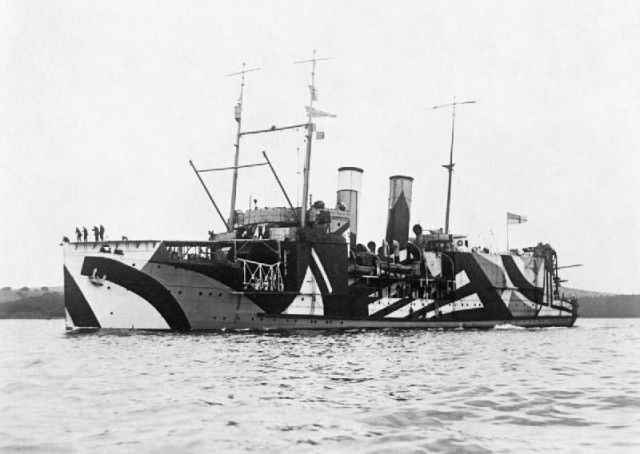
HMS Pegasus was an aircraft carrier bought by the Royal Navy in 1917. Originally commissioned by the Great Eastern Railway Company in 1914 the ship was converted for military duty. The vessel was sent to support the Grand Fleet in the North Sea, but Pegasus did not see any military combat.
The dazzle patterns used here not only incorporate bold contrasting stripes but the design on this ship uses not only contrasting stripes but also curving patterns at the bow and stern to add further confusion.
USS Nebraska
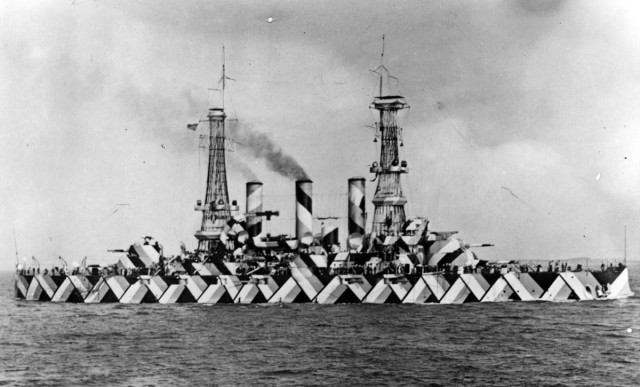
The Nebraska, which was launched in 1902 and decommissioned in 1916, was recommissioned a year later, just before the US entered the war. It was soon in use to help with the war effort being used mostly as a training and escort vehicle. In 1918, the Nebraska joined the increasing ranks of Dazzle ships with a zigzag pattern with a striking 3D effect.
Modern Revival of interest
HMS President.
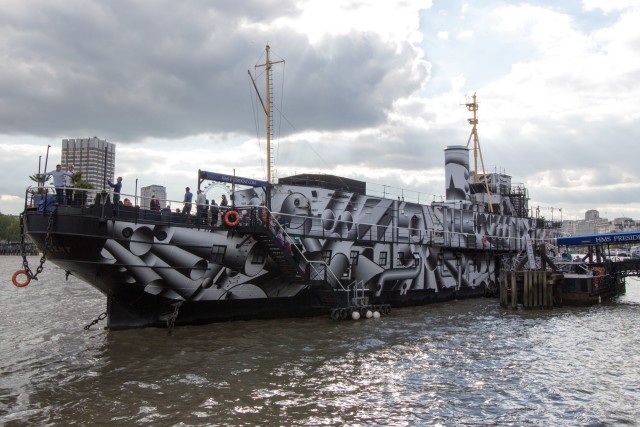
HMS President was a flower class sloop. Designed as a minesweeper and escort vehicle this class of ship had triple bows for additional protection. Above, HMS President has been decorated with a modern interpretation by contemporary artist Tobias Rehberger to commemorate the work of WW1 dazzle artists.
A renewed interest in this art form has led to the appearance of a number of modern dazzle ships although, with these, the emphasis is on artistic effect.
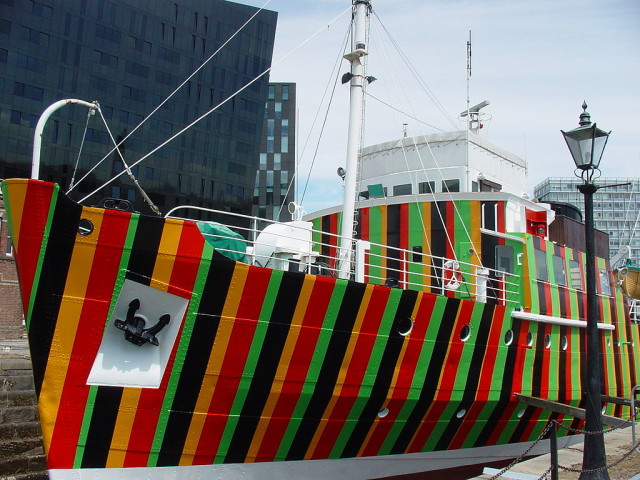
The ship above was painted to commemorate dazzle paint for the Liverpool Maritime Museum.
Was Dazzle Camouflage a success?
Dazzle painting was controversial. Some claim it was adopted out of desperation after suffering heavy losses at sea, and it was criticized as being unscientific. This was quite reasonable as the idea had not been tested before or subjected to much scrutiny before being put into action. Testimony from some of those who encountered dazzle ships suggests that it might have been effective.
A German U-boat captain described how he didn’t realize until the ship was only half a mile away what kind of ship it was and what direction it was traveling. No conclusive research was conducted on its effectiveness, and some senior naval figures remained skeptical.
Perhaps because of this, the technique was only used to a very limited extent during the Second World War.
